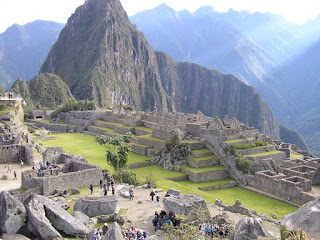the Taj Mahal in India
the Great Wall of China
Christ the Redeemer statue in Brazil
Chichén Itzá in Mexico
the Colosseum in Italy
Petra, Jordan
Yay!!!!
The other finalists were:
Easter Island, Chile
the Statue of Liberty in the U.S.A.
the Eiffel Tower in France
Angkor Wat Temples in Cambodia
the Alhambra in Spain
the Acropolis in Greece
Hagia Sophia in Turkey
the Kiyomizu Temple in Japan
the Kremlin/St. Basil in Russia
the Neuscwhanstein Castle in Germany
Stonehenge in the U.K.
the Sydney Opera House in Australia
Timbuktu in Mali
You might be asking: why did people decide to redo the list of the seven wonders of the world?
The reason is the only ancient wonder still standing today are the Pyramids of Giza. The old list was a little outdated too, (complied over 2000 years ago) and the choices were only situated around the Meditarranean.
Machu Picchu totally deserved this recognition for being a symbol of what communities can do together and for each other, and for astounding craftsmanship in the architecture and for the perserverance it must have taken to accomplish.
Some Interesting Facts:
- Machu Picchu is Quechua (Incan language) for "Big Mountain" and was not the name of the actual city when the Incas lived there. The real name was forgotten. The city was dubbed "Machu Picchu" only because that is the name of one of the mountains near it.
- The city was built by the Incan people, built on a cliff in the mountains and surrounded at that time by a thick jungle cover that prevented it from being found and destroyed by the Spanish. Machu Picchu was so well hidden that it wasn´t found until 1912 by Hiram Bingham, who was actually looking for El Dorado. Instead, he stumbled upon a lost city of the Incas, of which still contains 80% original material from the day it was abandoned.

Machu Picchu in the afternoon light.
 A nice view of the city of Machu Picchu, and also Waynapicchu the mountain behind it, at about 7 a.m.
A nice view of the city of Machu Picchu, and also Waynapicchu the mountain behind it, at about 7 a.m. Ali and I in front of Machu Picchu.
Ali and I in front of Machu Picchu.
A view of Putucusi, a mountain we had climbed the day before.

A view of Machu Picchu from the top of Putucusi from the day before.
 A view from the inside of the city. The long grassy rows were for agriculture, and other side where the picture was taken were houses where people actually lived.
A view from the inside of the city. The long grassy rows were for agriculture, and other side where the picture was taken were houses where people actually lived.
A house that would be covered with a thatched roof, changed every year after the rainy season. Families would basically only sleep (on animal skins) in their houses. Our guides told us the Incas were health-concious, and that their life expectancy was higher than Perú's is today (75 in Incan times, 65 for Peruvians today).

Restoration of what their houses looked like.

Mountains and city.






Looking down from the top of Waynapicchu.

Aguas Calientes, a purely tourist city at the bottom of Machu Picchu where we stayed the night.



Sacsayhuamán, an old fortress. In present day, the place is now used for the Sun Festival.
Ruins near Pisác, another ancient Incan city.

Women and children in traditonal clothes with their cash/money. Alpacas are a good source of clothing and food, and are sold all over and known as the "gold of Perú."








2 comments:
all i can say is wow... can't wait to hear about all of these amazing places!!!
CRAZYYYYYYYYYYY
sooo prettyyyy
cant wait for u to come backk
Post a Comment